By Justin Black of Spycraft101
Among intelligence agencies and clandestine organizations, the High Standard Model HD Military Silencer (MS) is the standard for suppressed pistols by which all others are judged. First adopted by the famed Office of Strategic Services in early 1944, it saw service in all theaters of World War II. The pistol was so effective that it remained in the inventory of the Central Intelligence Agency as late as the 1990s and possibly beyond.

Throughout its short lifespan, the OSS worked tirelessly to develop the best possible silent weapons for field use. A variety of initiatives were implemented, ranging from the creative to the downright bizarre (see this post for some examples). Among these were the Bigot system, which was a conversion of the standard government issue 1911 to allow it to fire a heavy steel dart using a captive .25 ACP blank round.
Several crossbows were developed as well, most famously the Little Joe, which made its way into the hands of the Alamo Scouts in the Pacific Theater for operational testing. There was even a CO2 dart gun known as the SAC-46 Flying Dragon, which was envisioned with poison-tipped darts for instantaneous takedowns of sentries or assassination targets.
But none of these amazing projects offered a significant advantage over the High Standard Model HD MS (sometimes written as HDM/S). Lightweight, reliable, quiet, and accurate, it was hard to beat.
With the integrated suppressor and proper ammunition, the pistol produced a mere 20 decibels of sound, approximately the same noise level as a person’s muffled cough. Stanley Lovell, the head of research and development for the OSS, reported in his biography that Wild Bill Donovan smuggled a Model HD MS into the Oval Office in 1942 and fired it into a sandbag while President Franklin D. Roosevelt spoke on the phone, oblivious to what was occurring just a few feet away.
Lovell’s penchant for hyperbole must be taken into account here, and the story is likely apocryphal. But the Model HD MS was without question a quiet and effective killing tool.
Prototypes and Variants
A single prototype .380 ACP caliber model was built, known as the P-380. It was both louder and heavier than the .22 long caliber Model HD MS, but these were initially considered acceptable compromises considering the much-improved ballistic performance of the .380 ACP round.
Production of the P-380 was initially halted in October 1943 when Colt refused to manufacture barrels in either .32 or .380 caliber. Negotiations eventually moved forward and a manufacturing run of 1,000 pistols was scheduled to begin in August 1945. However, delays lead to the date being pushed back to September 15th, 1945, and by that time the war was over, and the contract was canceled. Only one suppressed .380 ACP High Standard Model P-380 was ever delivered to the OSS.
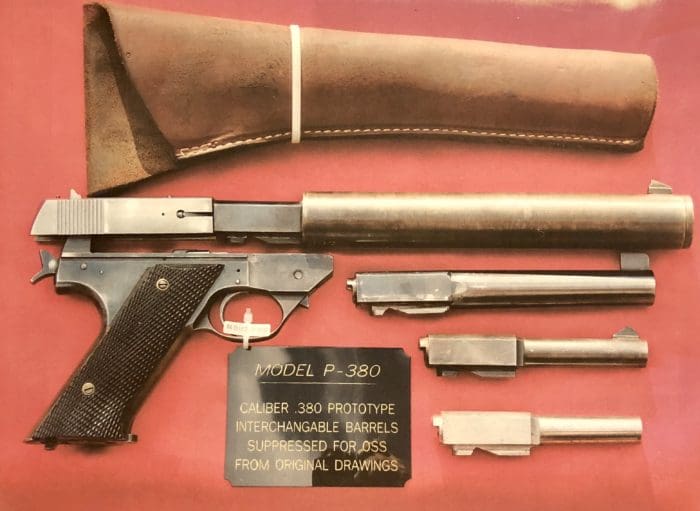
A .25 ACP caliber variant was also tested by High Standard in the early 1940s, but information on this prototype is extremely limited.
In 1944, the Infantry Board conducted tests on the HD MS which included the manufacture and use of a folding wire shoulder stock. The stock was a simplistic design. A 0.4” steel wire with a single bend and an adaptor for quick attachment and detachment from the base of the pistol grip.
The stock provided an improvement in overall stability when firing but was far from ideal. There was no cheek rest, and the rear sights were just nine inches from the shooter’s face. When the slide recoiled during firing it tended to induce a flinch reflex during testing. The Infantry Board’s report published in December 1944 did not recommend adoption of the Model HD MS with wire stock as a useful weapon for infantry units.
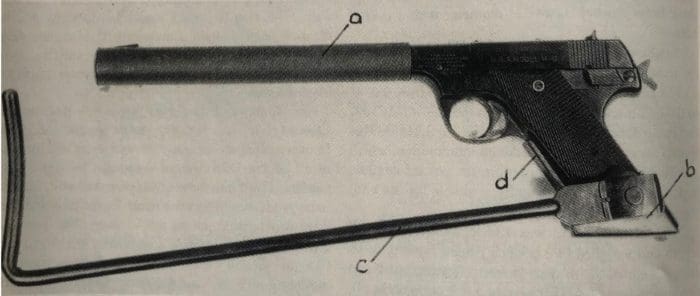
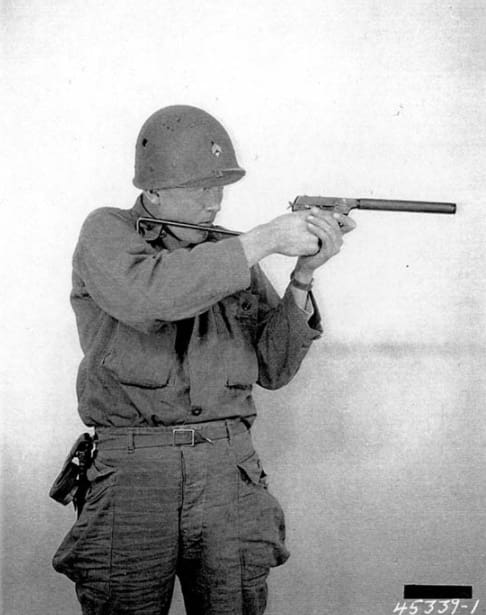
The OSS initially requisitioned 500 of the wire stocks, but eventually backtracked because the pistols they’d already issued had made their way to various field locations around the world, and mating the stocks with the pistols would prove to be a challenging logistical issue.
However, years later the Office of Technical Services within the CIA would test and adapt shoulder stocks for the Model HD MS once again. Army Lieutenant Colonel William “Bill” Parr worked as an engineer for OTS in the 1950s and 1960s.
In his interview for Robert Wallace’s book “Spycraft” he recalled that OTS worked with U-2 pilots to determine the best way for them to carry a Model HD MS with shoulder stock and holster in the cockpit. OTS engineers even converted some Model HD MS pistols to fully automatic fire. They were capable of firing 10 rounds in less than 1.5 seconds, after modification to the sear and magazine spring. Unfortunately, no photos of the CIA’s shoulder stocks are currently known to exist.
Service During World War II
By July 1944 nearly 1,400 Model HD MS pistols had been delivered to the European, Mediterranean, and Far East Theaters of Operation. The British Special Operations Executive also issued them to their own operatives.
Several of the new pistols were presented to high-ranking OSS officials and other dignitaries, including Admiral Chester Nimitz. This led to the inadvertent leak of the weapon’s existence and deployment when a photograph of Admiral Nimitz and his son Chester Jr. firing the pistol was published in the Philadelphia Inquirer newspaper on November 12th, 1944.
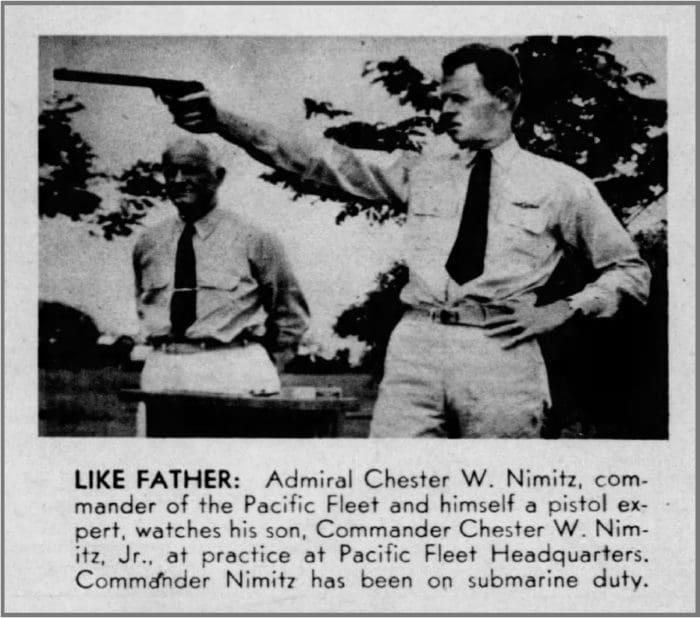
In the Pacific Theater of Operations, six Model HD MS pistols made their way into the hands of the famed Alamo Scouts. They used it primarily for the killing of sentries and foraging for food during long missions with little chance of resupply. The Alamo Scouts also tested another OSS weapon, the Little Joe crossbow, but found the High Standard to be the superior choice for their purposes.
It was also supplied to guerrilla organizations such as the French Resistance, who needed to be able to execute enemy troops and quickly disappear into the population at large without being detected or captured. In urban operations, the Model HD MS also proved valuable for surreptitiously disabling streetlights to provide the cover of darkness.
In the Mediterranean Theater of Operations, OSS Captain Lewis Allison reported that the HD MS was receiving high praise and were used constantly. The modus operandi there was to use the pistol for close-range sniping from windows, and against sentries as well. A 1945 report cited seven specific instances of successful use of the Model HD MS in field operations.
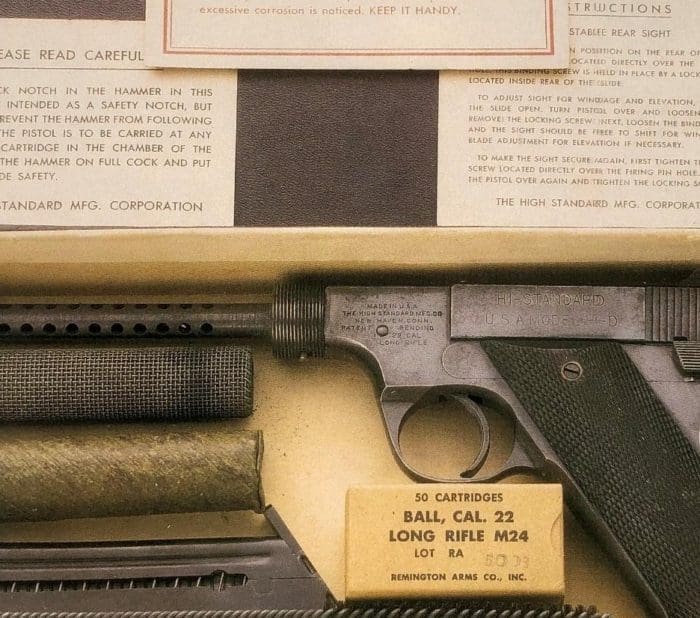
After the end of World War II (and the end of the OSS as well), High Standard pistols were transferred into the inventory of the newly formed Central Intelligence Agency. The CIA began issuing the Model HD MS with an additional .22 Short magazine as well as the standard .22 Long Rifle magazine. Once again it would find itself in the far-flung reaches of the world.
May Day, 1960
The Model HD MS’s greatest claim to fame (or infamy) is its fateful journey on May 1st, 1960 as the sidearm of choice for CIA pilot Francis Gary Powers on his doomed reconnaissance mission over the Soviet Union. Powers was piloting a high-flying U-2 reconnaissance aircraft at the time, photographing suspected Soviet nuclear testing facilities. When the Soviets detected his aircraft on radar they sent aloft a barrage of SA-2 surface-to-air missiles. Powers’ aircraft was hit, as was a Soviet MiG-21 that was pursuing him.
Powers survived the crash, parachuting to the earth. He was immediately surrounded by unarmed Russian civilians who were drawn by the spectacle of the crash and downed pilot. When Russian authorities arrived and detained him, his survival kit proved to be a treasure trove of intelligence and publicity value to the Soviets.
Not only was he carrying the suppressed High Standard, but also a silver dollar coin on a necklace. The coin held a hidden needle coated in saxitoxin, which Powers had been provided as a suicide implement if he feared for his life.
Now, more than 60 years later, that Model HD MS, serial no. 120046, resides in the KGB’s official museum in Lubyanka, home to their infamous headquarters which also served as an interrogation and execution facility.

Service in Vietnam
The Model HD MS also saw service in Vietnam with several organizations. Pilots employed by Air America, the CIA’s clandestine airline, were often equipped with the High Standard in shoulder holsters. It was equally popular with the Military Assistance Command – Vietnam’s Studies and Observations Group, or MACV-SOG.
MACV-SOG warriors carried an incredible variety of both US-manufactured and foreign weapons on their covert missions, and the High Standard was a mainstay of their arsenal.

One of the most difficult but valuable mission sets belonging to MACV-SOG was prisoner snatches. The exact methodology was a subject of endless debate among the teams, and constant experimentation on real-world missions.
One tactic the team used was to identify a VC or NVA courier with a formation of bodyguards and set an ambush. The ambush would be initiated by deliberately wounding the courier with the Model HD MS, while the rest of the squad was killed. The wounded courier could then be interrogated on site or extracted back to base.
On at least one occasion in Vietnam, the Model HD MS was used for a purpose for which it was completely unsuited. Army Green Beret Robert Castillo was on a five-day reconnaissance mission in 1971 deep inside enemy territory. Overnight he rested with his back against a tree and the Model HD MS in his lap.
In the middle of the night he was approached by a tiger smelling a potential meal. Castillo remained silent for as long as possible until the tiger was just a few feet away. He then raised the .22 pistol and emptied the magazine directly into the tiger, certain he was about to be eaten. The .22 rounds were not enough to kill the massive predator immediately but it drove it away, and Castillo survived to complete the mission.
In the fall of 1969, a Vietnamese agent of the Central Intelligence Agency used a model HD MS to assassinate a People’s Minister of Mobilization in a public park in broad daylight. The suppressor was so effective that witnesses did not realize that the Minister had been killed initially and thought that he had died of a sudden heart attack. The assassin was able to slip away in the confusion unnoticed.
The following year, a combined team of Army Special Forces Soldiers, CIA personnel, and South Vietnamese partners were able to capture a Viet Cong general officer by silently killing his security detail as the general slept in a remote plantation house. He was then awoken and informed of his own capture by the South Vietnamese.
One use of the Model HD MS lead to a major scandal which played out in the American news media in 1971. Two years prior, eight Army Special Forces Soldiers led by Captain Robert Marasco had identified a double agent among their Vietnamese partners. Thai Khac Chuyen was being paid by the CIA to develop a network inside Cambodia but was also working at the behest of General Duong Van Minh, who himself was working with communist forces to unify South and North Vietnam.
Chuyen’s betrayal of his US partners was uncovered when a Viet Cong camp was raided, and the ensuing site exploitation turned up a photograph of Chuyen with a high-ranking Viet Cong official.

Captain Marasco claimed he had received oblique instructions from his CIA partners to eliminate Chuyen “with extreme prejudice.” The eight Soldiers told Chuyen they had another mission for him, but detained and interrogated him using sodium pentothal, which elicited a confession. They then took him on a boat out into the South China Sea and killed him with a Model HD MS. His body was never recovered.
Although the eight Soldiers were eventually charged under the Uniform Code of Military Justice, they were never arrested or convicted due to an (unsurprising) lack of cooperation from the Central Intelligence Agency.
Conclusion
It is difficult to say where most of the approximately 2,600 original High Standard Model HD MS pistols are now, more 75 years after they first appeared. A few are in private collections, a few more in various museums. Some were certainly lost, or deliberately destroyed. As late as the year 2000, the USMC 1st Force Reconnaissance Company had ten Model HD MS pistols in their armory.
Author Gene Williams says he personally saw one in the hands of a “special forces contractor” in Afghanistan after 9/11. And a few more are undoubtedly in the inventory of some clandestine organization, or buried in a secret cache, awaiting their return to action.

Bibliography
- Wallace, R. and Melton, H. (2008) Spycraft. Penguin Group.
- Miller, J. (1998). The High Standard USA HD MS. Small Arms Review.
- Miller, J. (2000). Infantry Board Test of the High Standard USA Model HD MS and Wire Shoulder Stock. Small Arms Review.
- Brunner, J. (2005). OSS Weapons – 2nd Edition. 2005. Phillips Publications
- Philadelphia Inquirer. (1944).
- Conboy, K, The History of Halo Operations: Vietnam 1970-1971.
- Williams, G. (2017). The High Standard Model HDMS: A Silent Pistol Used by MACV-SOG. Southern California Sentinel.
- Paulsen, A. (2002). HDMS Silenced .22 Pistols in Vietnam, Small Arms Review.
- Darnton, J. (1971) Ex-Beret Says He Killed Agent on Orders of CIA. New York Times.
- Rogers, P. (2000). Strong Men Armed: The Marine Corps 1st Reconnaissance Company. ForceRecon.com.

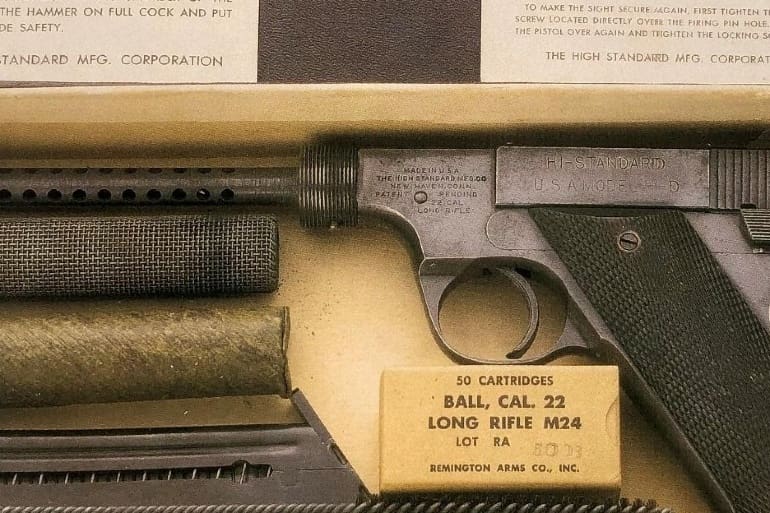



Lede, Lead, Led, Lead. The differences are important, but American English is just a sloppy language. I suspect there will come a day when anything and everything can be communicated with just the seven words you can’t say on TV. Spelling will be irrelevant if one means well.
Sorry, Samuel, the Devil made me do it : 😉
“Sorry, Samuel, the Devil made me do it :”
Naturally. But you could have confined it to the booth in the back, in the corner, in the dark.
Now where’s the fun in that? 🙂
(I’ll get my coat…)
Despite how it meters, an HD MS with fresh screens sounds subjectively as quiet as any integral Ruger produced in the last thirty years with “modern” internals. I’ve been fortunate to hear and shoot three originals and one Arms-Tech replica made to the original design.
One of the three originals I got to fire was the actual unit from the Robert Morasco affair during the Vietnam conflict. While doing some consulting for the U.S. Army Crime Lab in the early 00’s, I got to handle and shoot a number of extremely rare suppressed guns. One was a Walther MP-K with a Siegfried Huebner designed silencer. Another was the HD MS in question. It had come into the custody of the crime lab when the potential prosecution of the soldiers was being debated. We got to look through their log and determined that this was indeed that same HD MS. A unique aspect of this particular HD MS was that the manufacturer’s information was milled off the receiver. A similarly sanitized HD MS can be seen in Dave Truby’s “Silencers, Snipers, and Assassins” in a picture featuring a young Robert K. Brown holding it up while aboard an aircraft.
The HD MS is one of my all-time favorite suppressed firearms.
Mike Smith
20 Years AAC
Now Dead Air
“A unique aspect of this particular HD MS was that the manufacturer’s information was milled off the receiver.”
I think that was the way they came back then, for plausible deniability reasons if found ‘in the wild’.
You mention the one you had used screens, that kinda kills the usability of it on a day-to-day basis for us peons. You being a SOT manufacturer can have benefits we usually can’t…
Cool info, I’ve often wondered at the efficacy of the WWII era mesh suppressors, interesting that they sound similar to modern baffled cans to the ear if not the meter. I think I saw the Griffin guys metering an actual Maxim silencer once, it would be cool if more of these early cans got metered, you always hear almost mythical performance accorded to integrals of the era such as the Welrod and the DeLisle, I’d love to know how they actually compare.
Phil Dater of Gemtech got to meter a .32 Welrod and published the results in an SAR article I believe. With a fresh set of wipes, I believe it metered around 120 dB. I recall someone metered one of the Valkyrie Arms Delisle replicas, but the performance numbers don’t come readily to mind.
American Machine and Foundry did some work with Bell-Labs-style screen silencers in the 60’s. AMF used stainless screen instead of tin-plated bronze. The report on their work, which you can find available, is an extremely interesting read. The real prize that came from AMF’s work was the two stage integrally suppressed Carl Gustaf M45 (Swedish K) 9mm sub gun that was used by the Seals in Vietnam.
Neat article, but 20db is not believable, even the bolt closing on a semi auto often meters at 110db or so.
I came here to say the same thing. The last time I checked, a cough was closer to 70 dB and a whisper is about 30 dB. A bolt closing on a 10/22 is on the order of 110 dB. That 20 dB number is utter hogwash. Nonetheless, this is a great article.
I think the bolt closing is something like 40 decibels. A chainsaw is 110.
I seriously doubt that 20 decibels is real, but I know that on my integrally suppressed M&P 15-22 the bolt closing is definitely louder than the report of the rifle.
I actually got that number from a video Jeremy S who writes here did on the SiCo Switchback, at around 7:50 they show the bolt closing on a 10/22 at 104db, so a hair quieter than I recalled, but still in the ballpark
Possible the intended message was that it’s 20 dB louder than some baseline noise, not that it only produces 20 dB total. Dunno. Might dive into it a little. Cuz yes the idea that it’s only 20 dB is not realistic as that’s literally quieter than a whisper. Normal conversation is like 55 dB. So the claim in the text that a muffled cough is 20 dB is also very low. Perhaps the numbers are from an old source that was more contemporary with this gun and the scale wasn’t what it is today? At any rate, I think the take-home that it’s about the same noise level as a muffled cough is realistic and more relevant.
Yeah, I’d agree with muffled cough, I’ve got an Oculus that’s pretty close to that quiet, and I imagine a good integral could get the rest of the way there, especially with a ported barrel dropping the velocity. Like I mentioned in another comment, I think a lot of these old suppressed weapons get a bit mythologized in the literature, and I’d love to see some objective measurements of how they actually stack up to more modern designs, though I’m aware that newer isn’t always better when it comes to suppressors.
Testament to quality of design and manufacture.
I had a non suppressed .380 Hi Standard. It was kind of big for caliber and the mag capacity was only 6 rounds.
Mossad sent many a terrorist and Nazi to Gehenna with the venerable .22 LRS caliber round. It was very popular with American counterintelligence. It’s killing ability rested on the fact that it could penetrate the skull without exiting allowing the round to bounce around inside the skull, thus increasing it’s effect. Many people write the .22 off as an under powered round, but when used for a specific purpose it can kill very effectively. Growing up we used a .22 caliber rifle hundreds of times to kill hogs, cattle and possible even an occasional deer for butcher. A well placed shot either behind the ear or between the eyes would drop them stone dead. The use of the .22 caliber round has more to do with shot placement than impact energy. Either way I can’t imagine there’s anyone out there you would be willing to take a round to prove it’s ineffectiveness.
I wouldn’t volunteer to take a fastball to the torso, but that doesn’t mean I think it would kill me.
Hyperbole Much???
A lot of us are sick of this argument that goes like “I wouldn’t volunteer to get shot with it, so therefore it’s an extremely effective weapon”. Hence, we point out the fallacy in a sarcastic way.
I wouldn’t volunteer to let you shoot me with a 22Short derringer, but that doesn’t mean that it’s a good, effective choice for self defense.
Imagine what one of these would cost if it was in the registry today.
“Imagine what one of these would cost if it was in the registry today.”
My brain is fuzzy (substantially more than usual), but I seem to recall years back High Standard had a civilian version for sale.
At the least, there may be registered conversions floating around in the NFA market, by someone who was aware of the history and wanted one for themselves.
I’m kicking myself to this day for not jumping on a High Standard target pistol I saw on sale once for 75 bucks. it wasn’t one of those Olympic target pistols, just a solid one with moderate wear. It felt wonderful in my hand, tight and action slick as butter…
Is this the same company that makes the double nine revolver in 22lrf?
They did. I had a double 9 and a sentinal. Functional guns. I don’t know if HS is still in business.
Someone else may have the rights to the name, but the last time I saw a new one was in the late 80s.
That one wasn’t a particularly impressive example, the old ones in the display case at the gunshop I worked at the time seemed to be much better made that that one…
The one I saw was had bone grips that looked like they were polyurethaned idk if it was stock or not.
Very nice write up.
Thanks for the article, I enjoyed it much.
In a way it reminds me of the Man from Uncle gun used by Solo, may be that the inspiration for the tv prop came from this. Lots of spy and Army toys back then.
Good article. Thanks much!
About the sound levels of different suppressed .22s. I once shot a Ruger 10-22 with a screw on suppressor, in the test fire room in a shop that was dead quiet (the shop was). You literally could only hear the action cycle. No sonic crack so I guess the ammo was sub sonic. This was MANY years ago and was really interesting.
A comparable civilian weapon can be had provided the buyer can qualify for the ATF tax stamp.
A Ruger MkIV Tactical with Dead Air Ghost/Mask would be the modern equivalent. See the Military Arms Channel on YooToob for a good demo.
Love here history articles!
Yep. One of only two I read all day.
And the master sergeant in the boat later became a First Sergeant at Ft Bragg, Top of the engineer and weapons course trainees.
I might be wrong, but it sticks in my mind that the MACV-SOG guys also had a specialized variant of the M-16 that was designed to have a report that sounded distinctly like an AK.
XM177 with a “moderator” to make it sound more like an AK; incidentally, said “moderator” is classified as a silencer by the ATF, even though the actual decibel reduction is minuscule
https://en.wikipedia.org/wiki/CAR-15_XM177
The way I heard it, it was actually a loudener. But so was the original muzzle device for the MPX carbine, and the drug gang known as BATFE said that was a silencer too, so it probably doesn’t matter.
“This little doodad is my own invention. I call it a loudener.”
A single prototype .380 ACP caliber model was built, known as the P-380. It was both louder and heavier than the .22 long caliber Model HD MS, but these were initially considered acceptable compromises considering the much-improved ballistic performance of the .380 ACP round. v88.ca/3f5h
A fine history! Thank you. Please keep ’em coming.
“Among intelligence agencies and clandestine organizations, the High Standard Model HD Military Silencer (MS) is the standard for suppressed pistols by which all others are judged.”
Yeah, I can say with certainty 99.999% the operators I worked with at “intelligence agencies and clandestine organizations” didn’t even know what what a High Standard Model HD Military Silencer, was, much less think it was some kind of standard to be judged by. LOL
Any one know the current value of an original military us govt marked HD suppressed?
I doubt there are two dozen on the registery of the 1934 NFA. Having said that the last one that I saw several years ago, and I do mean over a decade ago sold for $25,000 plus dollars. You might as well be collecting NAZI Enigma Crypter Machines! There are some original High Standard HD’s with new cans that are refakes out there in NFA land that are waiting to be owned. They are looking for $3K price range for their refakes. I have a Ruger MK type Pistol with a six inch suppressor that is commercially made, sold, and lawfully registered under 1934 NFA. It is very quiet. I estimate it is between 115 and 120 db. I will cycle standarammo. Subsonic Ammo must be manually operated and it is not much quieter…
I am extremely fortunate to have access to an authentic HD-MS back in the early 2’000’s. While I was with AAC, we shot and sound tested the HD-MS against a state-of-the-art (for the time) AAC Phoenix suppressed Ruger MkII. The Phoenix delivered ~ 110 dB using a B&K 2209. The HD-MS did ~ 128 dB. Funny thing was, the HD-MS subjectively sounded just as quiet as the Phoenix.
The HD-MS is the secret sauce that sounds incredible.
Mike Smith (SilentMike)
Dead Air
AAC 1998-2018